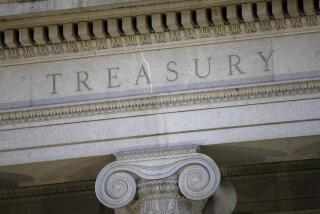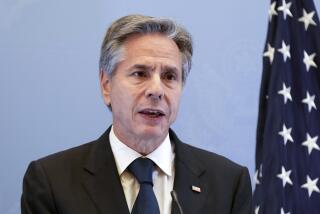Trump keeps Iran nuclear deal intact but adds unrelated sanctions on Tehran
President Trump agreed Friday to extend sanctions waivers on Iran to keep the landmark nuclear disarmament deal intact, but vowed to quickly withdraw from what he called “the disastrously flawed” accord unless it is significantly revised.
“No one should doubt my word,” Trump said in a harshly worded, two-page statement that also announced separate economic sanctions on 14 Iranian entities and individuals.
Trump said he had reluctantly agreed to extend the waivers only in order to secure the support of America’s European allies to fix the agreement. “This is a last chance,” he warned, declaring he would not do so again.
He did not set a deadline, but under U.S. law the president is required to waive sanctions every four months. Unilaterally reimposing the sanctions would put the United States in violation of an international agreement that was unanimously approved by the United Nations Security Council in 2015.
Iranian officials have stressed they will not reopen negotiations on the accord, which required Tehran to dismantle or destroy most of its nuclear infrastructure in exchange for easing of most international sanctions. The U.N. nuclear watchdog agency has repeatedly found Iran is complying with those obligations.
Senior administration officials said the White House intends to negotiate with European allies a menu of “triggers” to reimpose multilateral sanctions if Iran oversteps those lines. But the officials also want the triggers to include Iran’s growing ballistic missile program, which was not part of the nuclear deal, and to remove sunset clauses that allow some nuclear restrictions to ease or phase out over time.
“The idea is they [should] never expire,” a senior administration official, speaking anonymously, said of the restrictions in briefing reporters ahead of the announcement. “Iran should be denied all paths to a nuclear weapon … forever.”
The 14 Iranian individuals and entities sanctioned Friday include a notorious prison and members of the Islamic Republic’s judiciary who have sentenced dissidents to death.
Also blacklisted were Iran’s cyberspace agency, which administration officials said restricts its citizens’ access to the internet; Iranian defense industry firms that repair and maintain helicopters and aircraft; a Malaysia-based company that allegedly supports Iranian naval missile production; and a Chinese businessman who allegedly supplied financing and equipment to Iran’s electronics industry.
The head of Iran’s judiciary, Sadegh Amoli Larijani, was put on the U.S. blacklist. He is the brother of the speaker of the Iranian parliament, Ali Larijani, the officials said.
“These designations politically will go to the top of the regime,” said another administration official, also speaking anonymously, “and send the message that the United States will not tolerate the violation of the rights of [Iranian] citizens.”
The administration long has argued that all of Iran’s “malicious behavior,” including its human rights abuses and support for militant groups across the Middle East, should be included in an international regimen of punishment.
The nuclear deal was negotiated with Iran by the five permanent members of the U.N. Security Council and Germany. All sides agreed that it would only cover Iran’s apparent efforts to develop nuclear weapons, which was in violation of U.N. resolutions, and not other issues.
Trump has sharply criticized the agreement and vowed to rip it up, but his national security advisors have urged him to wait while they work with Congress and U.S. allies in an effort to strengthen its provisions.
As he did in October, Trump again declined to certify to Congress that the nuclear agreement is in the nation’s best interest. Noncertification to Congress does not affect the actual accord, however.
The consequences would have been far-reaching if Trump had decided not to continue waiving nuclear-related sanctions.
It would defy other members of the Security Council as well as most U.S. allies. It also could hand Iran a pretext to start limiting U.N. inspections or restart its nuclear program.
Sticking with the deal but imposing new nonnuclear sanctions while seeking to change the agreement was a compromise position.
Most U.S. trade with and investment in Iran already is banned under separate U.S. sanctions for Tehran’s human rights abuses, ballistic missile program and support for terrorism, but the administration and its supporters said more are needed.
European allies had strongly urged the White House to stick with the nuclear deal, saying a decision to abandon it would strain the transatlantic partnership.
French President Emmanuel Macron, in a telephone call with Trump on Thursday, emphasized France’s “determination to see the strict application of the deal and the importance of all the signatories to respect it,” Macron’s office said.
“The smooth implementation of the agreement should be accompanied by a stepped-up dialogue with Iran on its ballistic missile program and its regional policy in order to guarantee greater stability in the Middle East,” the French statement added.
Trump told Macron that Iran had to stop its “destabilizing activity” in the region, the White House said.
The accord required Tehran to dismantle its main nuclear reactor, drastically cut back on uranium enrichment, get rid of thousands of centrifuges and export most of its heavy water. Compliance has been verified repeatedly by the U.N.’s International Atomic Energy Agency.
In exchange, most international sanctions on Iran were eased, allowing the country to trade on the global oil market and rejoin international banking systems. Widespread protests in Iran over the last few weeks have focused on the country’s faltering economy, however, as well as high unemployment and government corruption.
For more on international affairs, follow @TracyKWilkinson on Twitter
UPDATES:
1:30 p.m.: This article was updated with details from President Trump’s statement.
11:20 a.m.: This article was updated with details from a White House briefing.
This article was originally published at 3 a.m.
More to Read
Start your day right
Sign up for Essential California for news, features and recommendations from the L.A. Times and beyond in your inbox six days a week.
You may occasionally receive promotional content from the Los Angeles Times.







